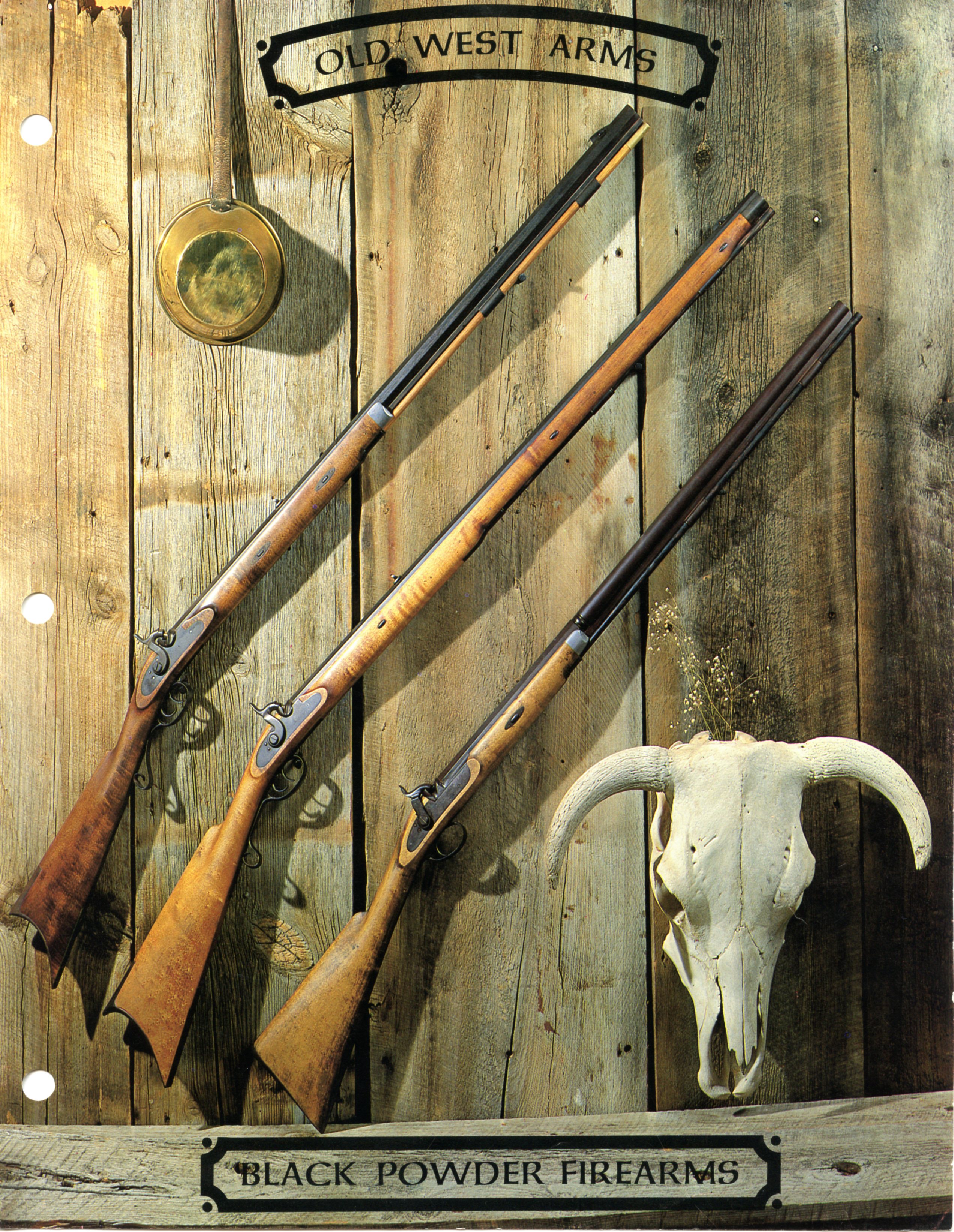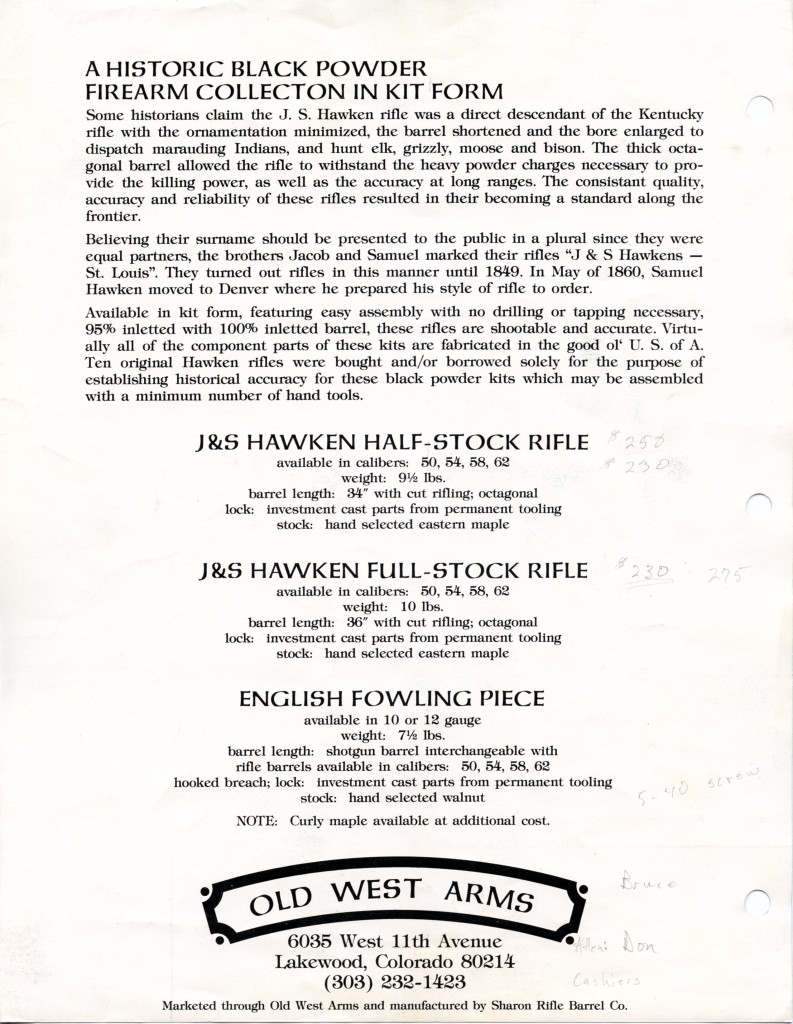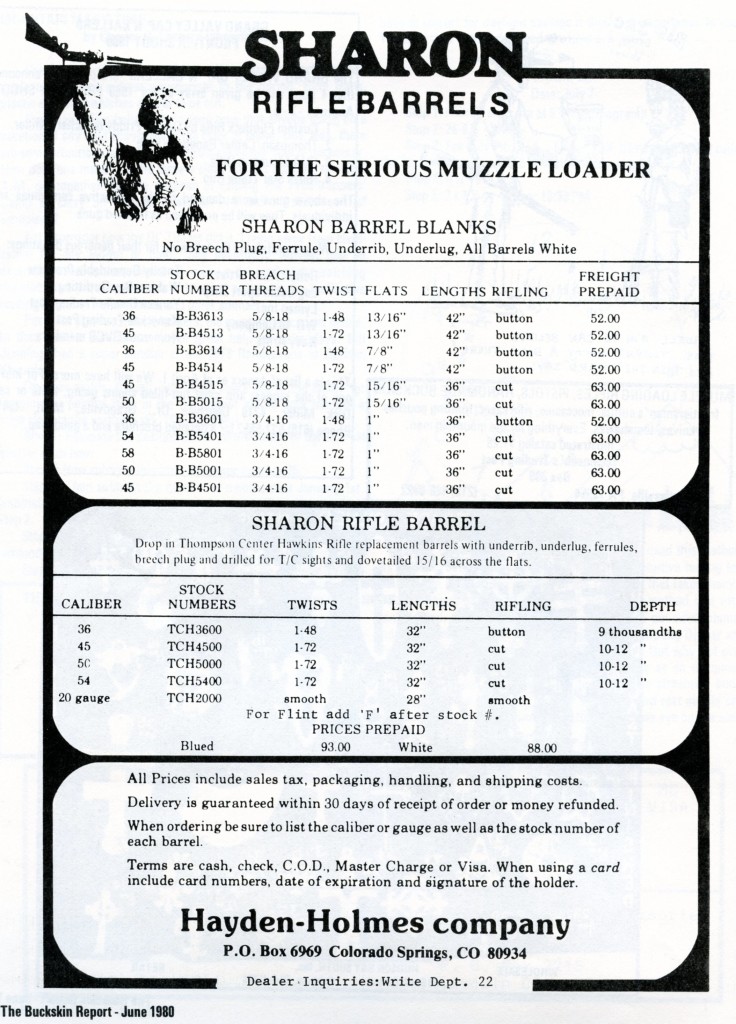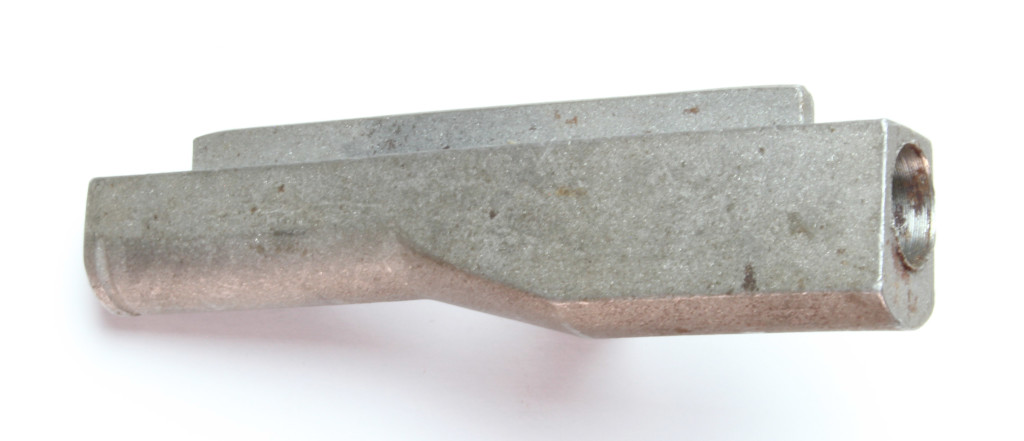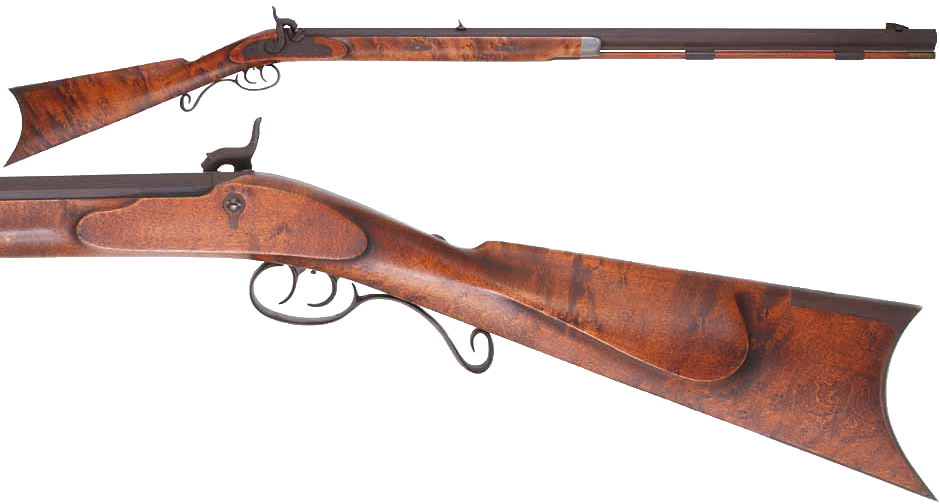COMPANY HISTORY
Hall Sharon had a background as a machinist and a gunsmith. Sharon had been established in California, but he wanted a change and purchased the gunsmithing and barrel making business of John Buhmiller in Kalispell, Montana in 1970.Sharon initially focused on making barrels for modern, high power rifles and quickly established himself as a respected barrel maker in that market. Looking to expand his business, he started making quality muzzleloader barrels in late 1973, about the same time GRRW was gearing up to make their own barrels.
Sharon Rifle Barrel Co. placed their first ad in Muzzle Blasts in the September 1973 issue, advertising pistol barrels.
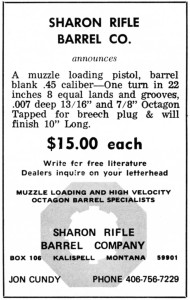
A year later, the first ad for a full line of muzzleloading barrels appeared in the September 1974 issue of Muzzle Blasts.
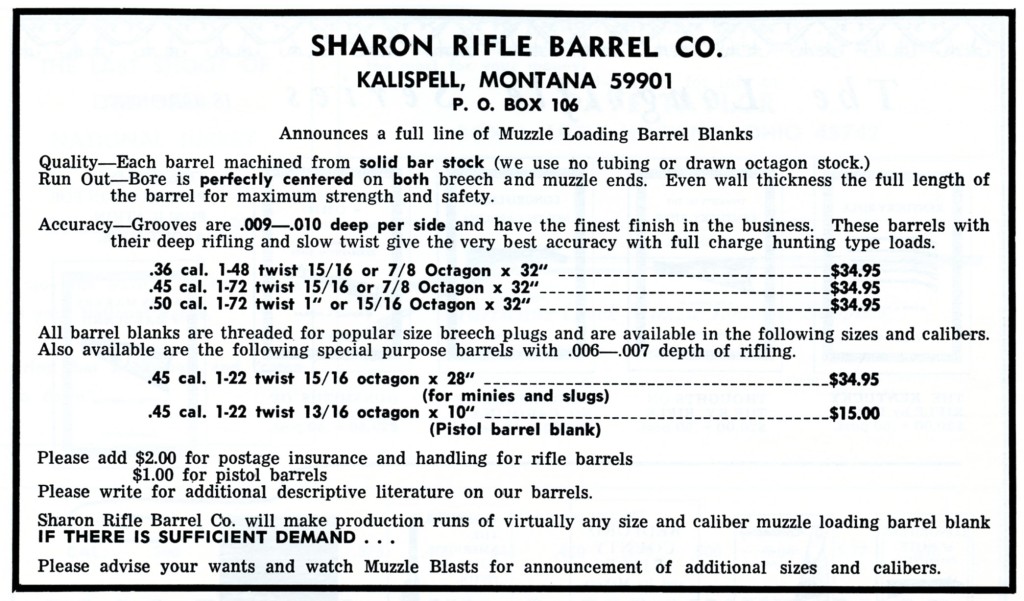
The company advertised regularly in the popular muzzleloader/black powder magazines of the day. This ad is from the May 1975 issue of BUCKSKIN REPORT magazine. They were making both straight octagon and tapered octagon barrels by this time.
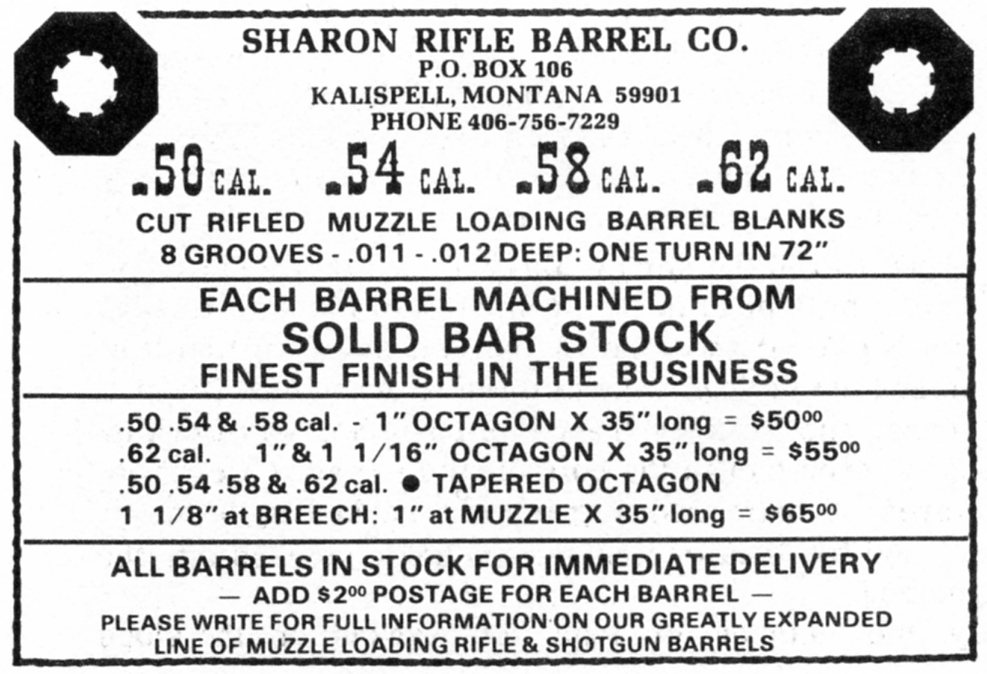
By January of 1976, they were advertising “swamped” barrels in Muzzle Blasts.
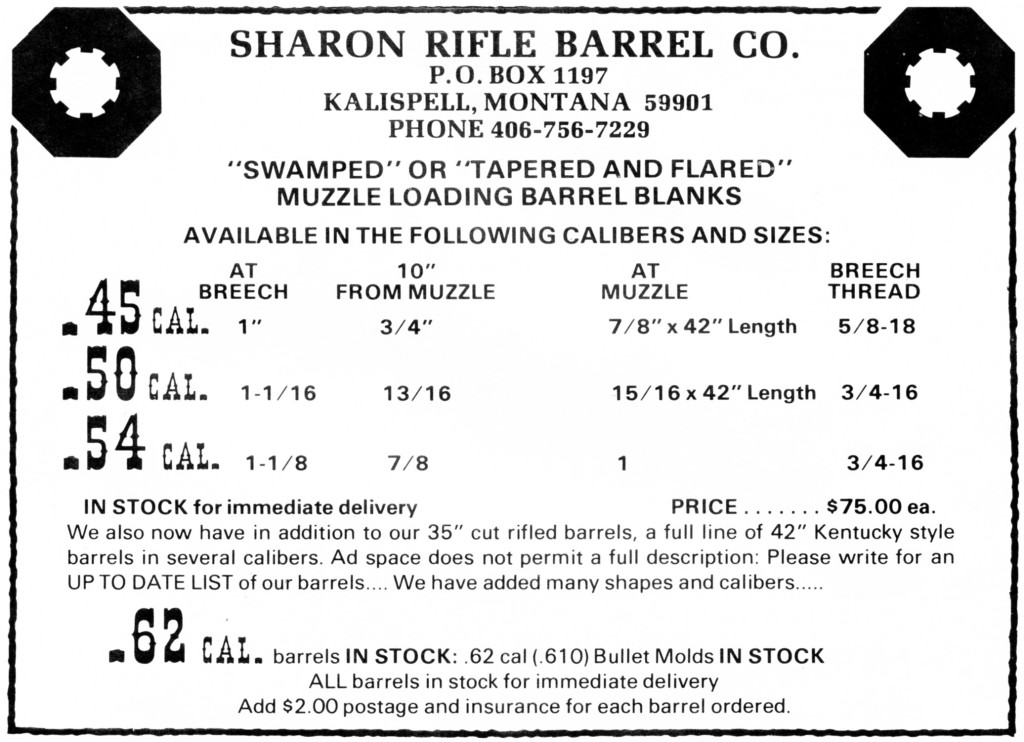
Sharon was soon selling barrels to various manufacturers of muzzleloading guns such as Thompson Center and Green River Forge, and also set up a wood shop to make stocks for other companies.
Sharon’s attention then turned to making parts for whole muzzleloading rifles and guns. The company started making Hawken kits in 1976. Sharon initially offered a half stock and a full stock Hawken. A smooth bore English fowling piece and a less common trade rifle would follow. Sharon’s Hawken kits were well received in the marketplace, helped by the positive reputation their barrels had established.
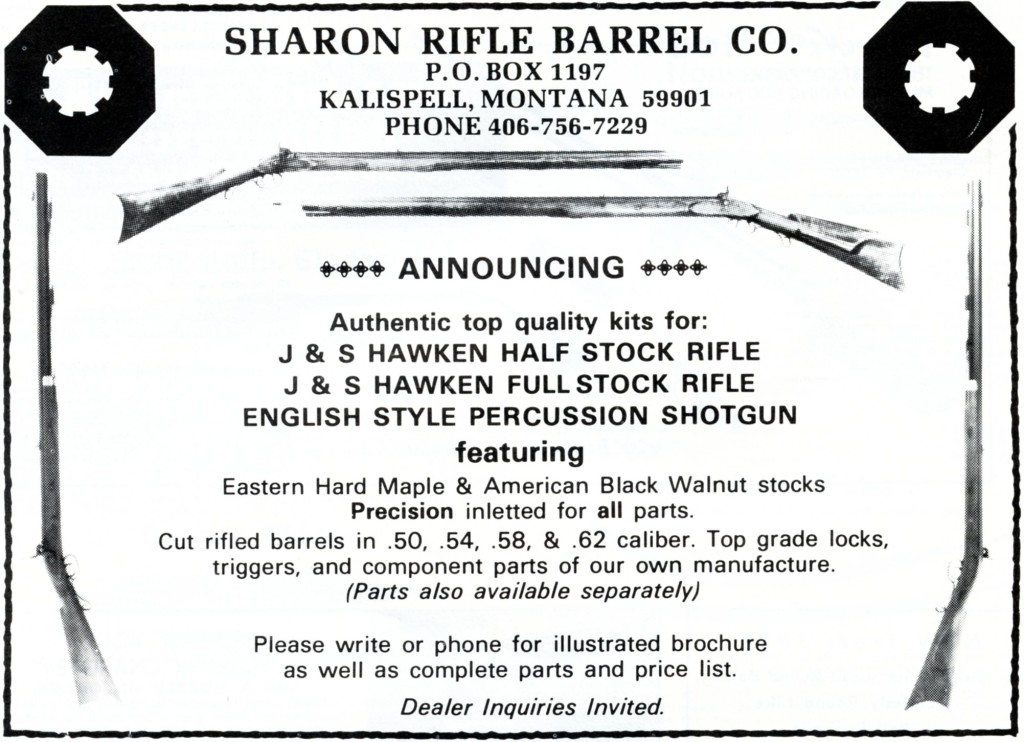
The ad above ran in both The Buckskin Report and Muzzle Blasts through the rest of 1976. I couldn’t find any Sharon Rifle Barrel Co. ads in 1977.
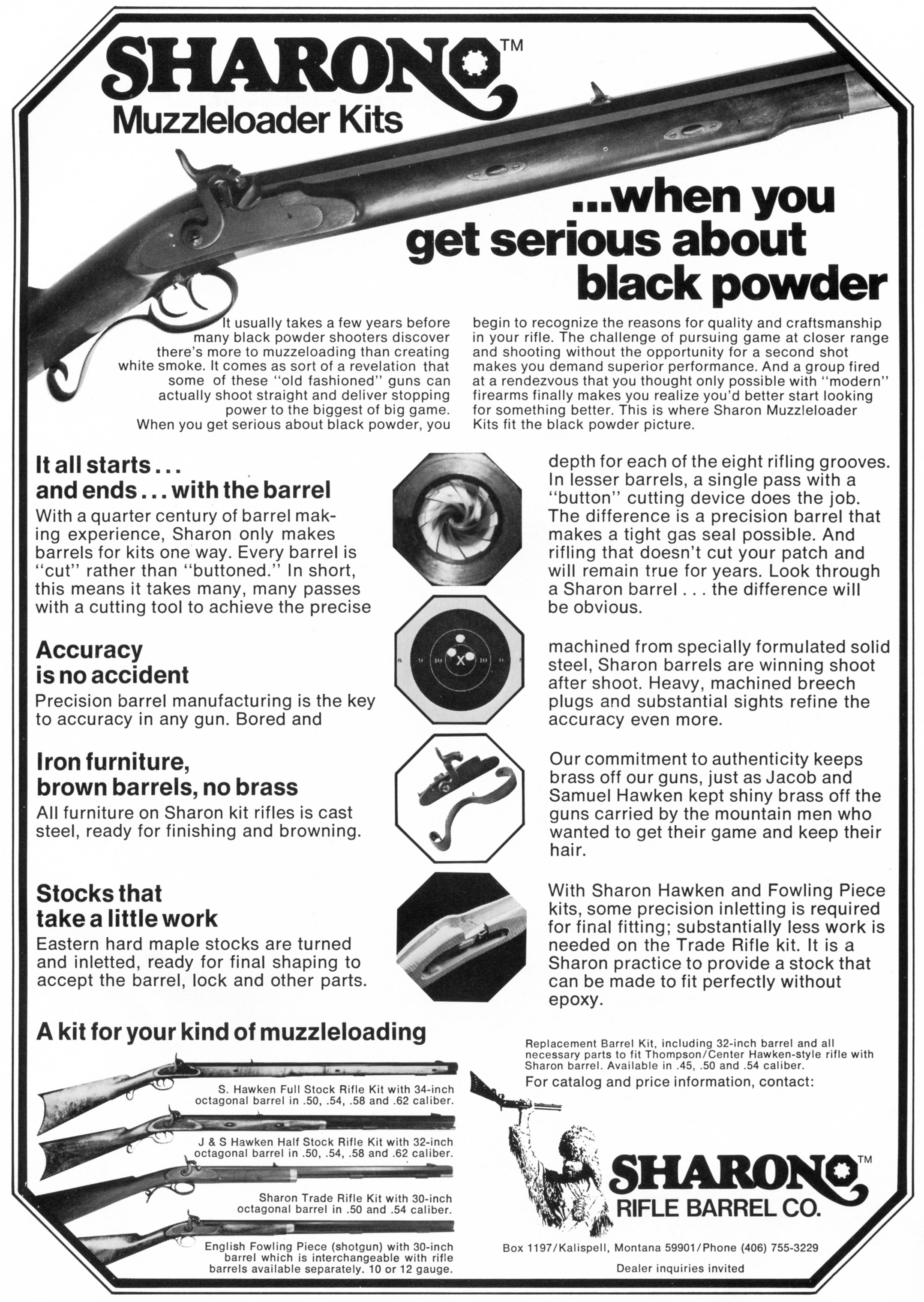

These two ads were run in Muzzleloader in the first half of 1978.
Muzzleloader had a write-up on Sharon in the May-June 1978 issue which gave a good review of their operations. This is the first page of the three page article.
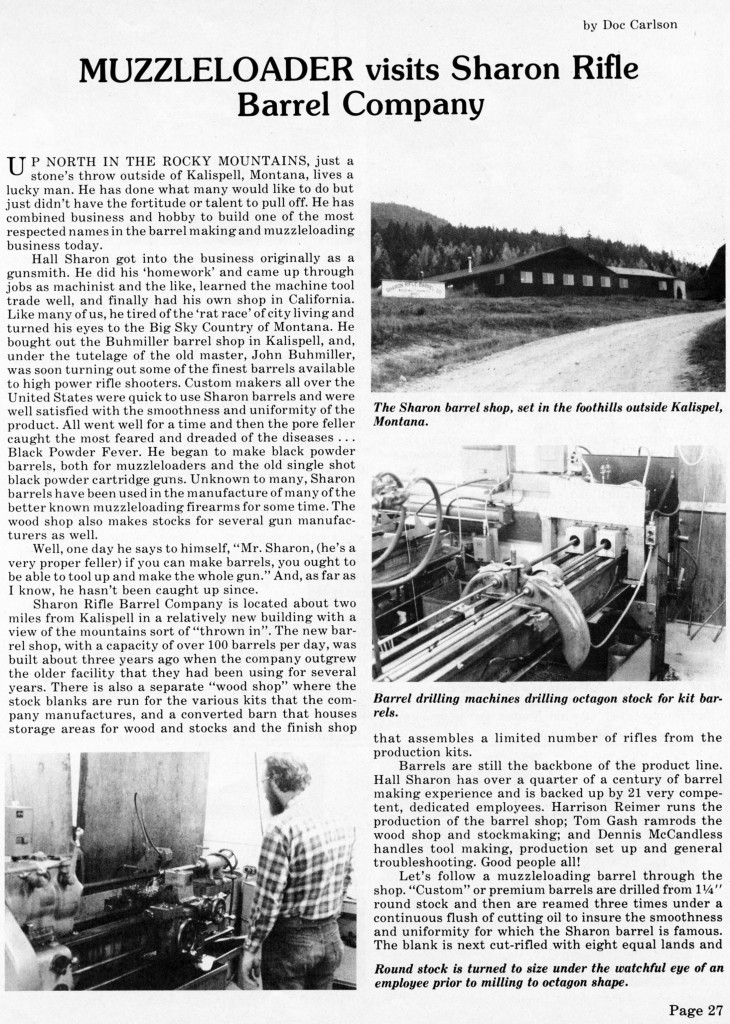
Then in the September 1978 issue of The Buckskin Report, this notice was published.
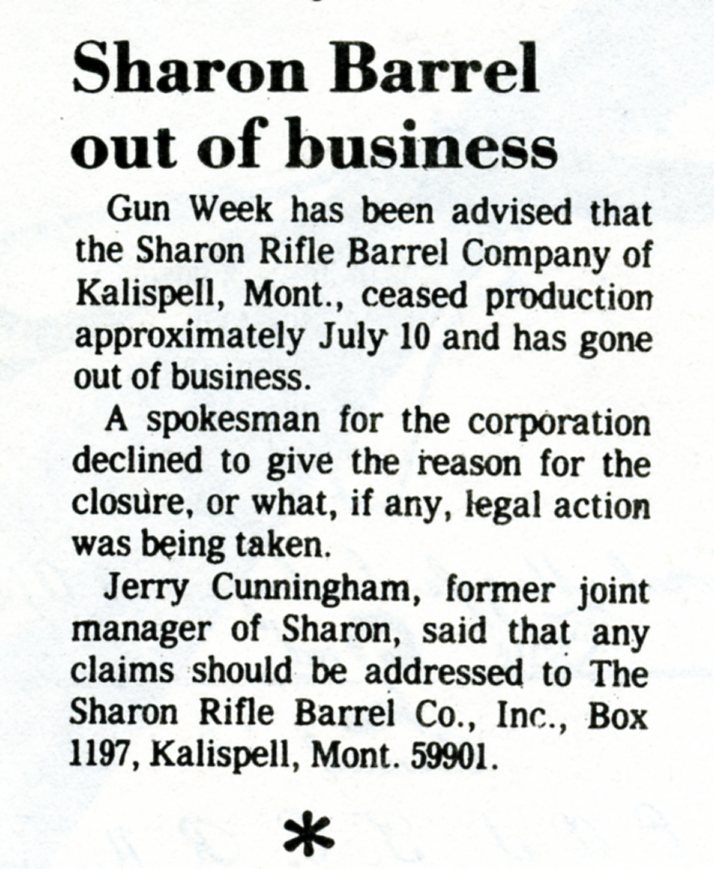
The company apparently expanded too rapidly, ran into financial trouble, and closed in July of 1978. The late 70’s were challenging times for businesses as interest rates and inflation had been increasing since the Arab oil embargo in 1973. A quadrupling of oil prices by OPEC coupled with high government spending because of the Vietnam War led to stagflation in the United States. Companies that borrowed too much money often had trouble makings principal and interest payments on their loans and were forced into bankruptcy.
The inventory of Sharon Hawken kits appear to have been sold during the bankruptcy proceedings as this ad ran in the May-June 1979 issue of Muzzleloader magazine. Note that they were offered by a company called Old West Arms in Lakewood, CO.
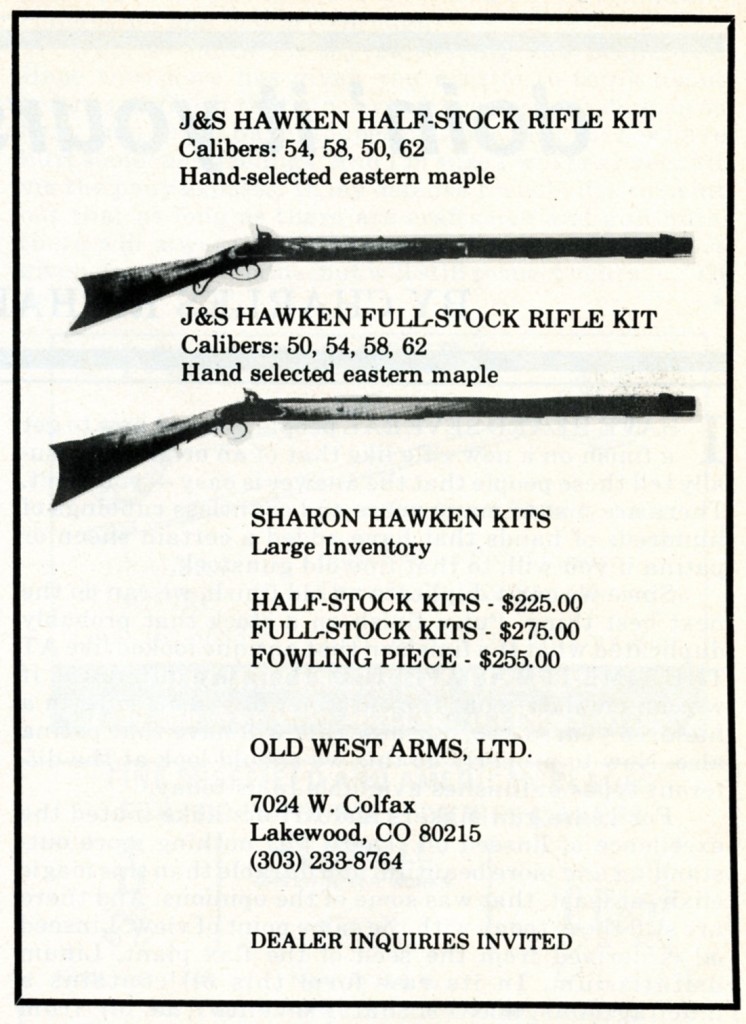
Old West Arms ended up with enough inventory of Sharon kits to continue selling them for a couple more years. I purchased a half stock Hawken kit and a full stock Hawken kit from them in 1979. At that time they were sending out these fliers.
Old West Arms was also a big dealer for GRRW guns. They ordered a number of finished rifles from GRRW for resale and even more semi-finished rifles went through their shop.
The barrel making equipment appears to have been sold to a separate company, also located in Colorado, but this time in Colorado Springs, called Hayden-Holmes. This ad appeared in the June 1980 issue of The Buckskin Report magazine.
The Hayden-Holmes company did not stay in business long for this notice appeared in the December 1980 issue of The Buckskin Report.
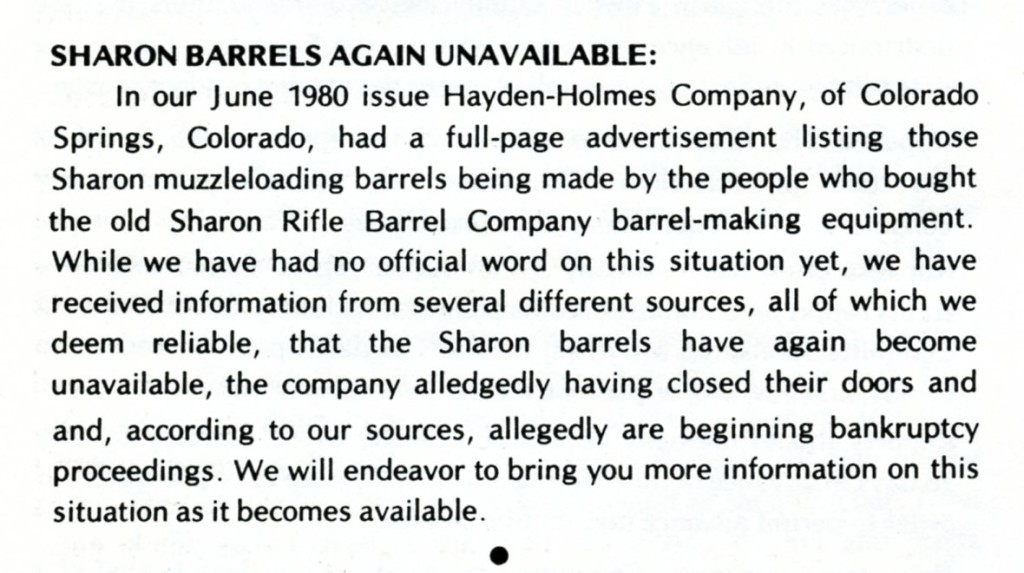
A couple months later, this notice was placed in the February 1981 issue of The Buckskin Report.
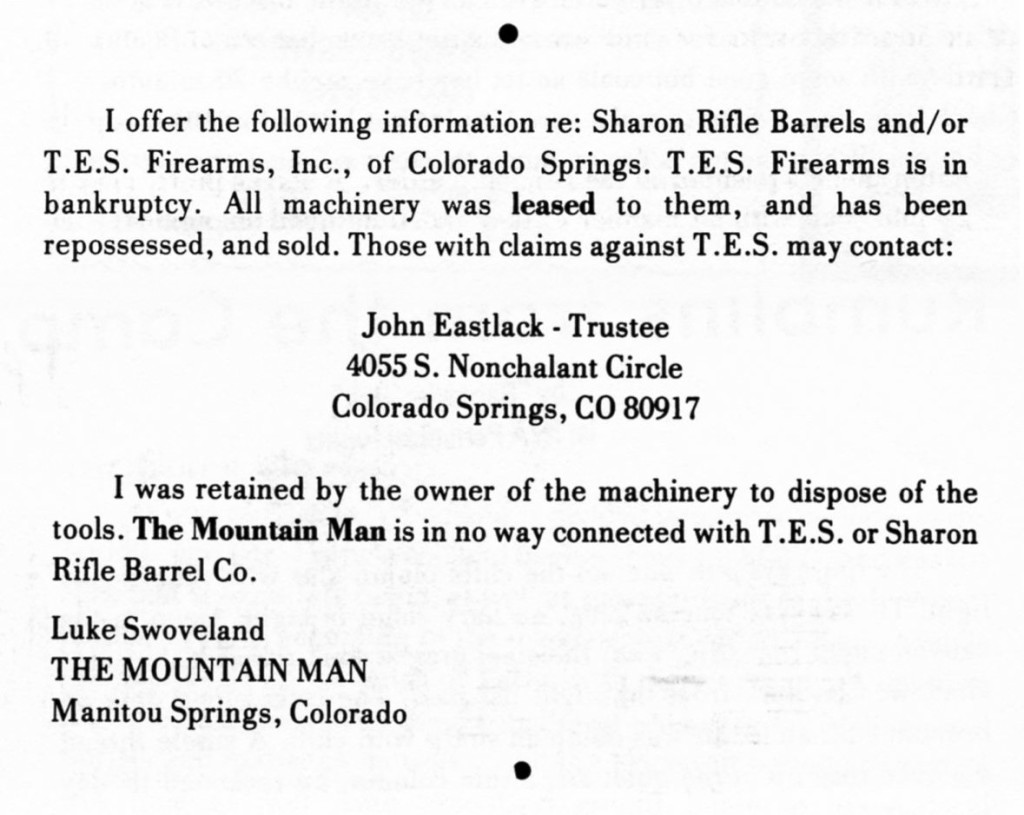
Sharon’s impact in the market is disproportionate to their time on the market. Their actual production run was less than two years with enough inventory built up at the time the company went under that another company was able to continue sales post-bankruptcy for another year or two. This speaks well to their quality and desirability.
THE HALF STOCK AND FULL STOCK HAWKEN RIFLES
Sharon’s early ads claimed the “locks, triggers, and component parts of our own manufacture”. This appears to be true of some of the component parts, but the locks and triggers were from L&R and carried the L&R stamp on the inside of the lock plate.
The breech plug & tang, ramrod thimbles, particularly the lower entry pipe, barrel wedge escutcheons, and butt plate are unique to the Sharon Hawken kits and likely of their own design and/or manufacture.
The shape of the snail on the breech plug is unlike any other plugs that were available from the suppliers of the day. It is so distinctive that it easily identifies a rifle as a likely Sharon kit. There is a wide variation in the style and shape of the snail on original Hawken rifles, so who’s to say that Sharon’s isn’t representative of an original Hawken somewhere.
The lower entry pipe is another distinguishing feature, but it may not be obvious on a finished rifle. The entry pipe is a cast piece that does not have the traditional skirt. The front pipe section and the rear skirt section were cast as one solid piece with tapered sides to facilitate inletting into the stock. A hole was drilled through this solid piece for the ramrod. It was probably designed this way to make it easier to pre-inlet the stock as well as making it easier for less experienced builders to properly inlet. The traditional entry pipe with a skirt is one of the more challenging parts to inlet on a rifle. Once properly inlet and the stock shaped and finished, one wouldn’t be able to tell the difference.
The butt plate on the Sharon half stock Hawken is the least authentic part in the set. The primary criticism is that the toe of the butt plate extends too far to the rear. One of the distinguishing features of an original Hawken rifle is that when holding the rifle with the barrel perpendicular to the floor and lowering it down, the heel of the butt plate will touch the floor first with the toe still a ¼” to ¾” off the floor. Conversely, the toe of the Sharon butt plate will touch the floor first.
The escutcheons for the barrel wedges on the half stock version are slimmer ovals (meaning the height of the oval versus its length is smaller) than commonly seen on other reproductions or original rifles. Pewter was provided to make a poured pewter nose cap on the half stock. This was a popular feature in the 1970’s and 1980’s, and a few existing original Hawken rifles have pewter nose caps, but some Hawken experts consider them likely replacement nose caps rather than original to the guns.
A totally different butt plate was provided with the Sharon full stock Hawken kit. It is an early style butt plate, and the same one that Don Stith occasionally includes with his pre-1840 J&S Hawken half stock parts set.
The full stock Hawken kit also came with a flat-to-wrist trigger guard. It had a patent breech, but it was fixed rather than hooked. It did not use any escutcheons for the barrel wedges and generally had a longer barrel than the half stock kit. A cast-steel, full-stock type nose cap was used. The lock, triggers, breech, and tang were the same on the full stock and half stock.
Considering that most of the criticisms are minor, the Sharon kits, in the hands of a skilled builder, could be made into a respectable Hawken replica. The classic lines were there. The components were quality. The barrels had a good reputation for accuracy and are still sought after today. They could be made to represent either an early pattern J&S Hawken or a later Sam Hawken pattern.
Return to The Heyday Of The Hawken
Return to GRRW’s Competition

